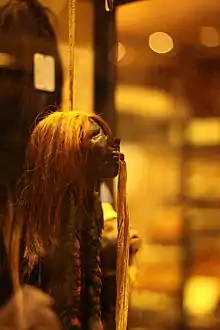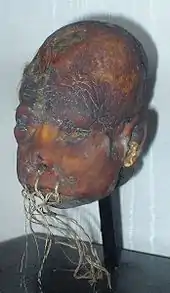Shrunken head
A shrunken head is a severed and specially prepared human head that is used for trophy, ritual, or trade purposes.

Headhunting has occurred in many regions of the world, but the practice of headshrinking has only been documented in the northwestern region of the Amazon rainforest.[1] Jivaroan peoples which includes the Shuar, Achuar, Huambisa and Aguaruna tribes from Ecuador and Peru are known to have shrunken human heads.
Shuar people call a shrunken head a tsantsa,[2] also transliterated tzantza. Many tribe leaders would show off their heads to scare enemies.
Process

The process of creating a shrunken head begins with removing the skull from the neck. An incision is made on the back of the ear and all the skin and flesh is removed from the cranium. Red seeds are placed underneath the nostrils and the lips are sewn shut. The mouth is held together with three palm pins. Fat from the flesh of the head is removed. Then a wooden ball is placed under the flesh in order to keep the form. The flesh is then boiled in water that has been saturated with a number of herbs containing tannins. The head is then dried with hot rocks and sand, while molding it to retain its human features. The skin is then rubbed down with charcoal ash. Decorative beads may be added to the head.[3]
In the head shrinking tradition, it is believed that coating the skin in ash keeps the muisak, or avenging soul, from seeping out.
Shrunken heads are known for their mandibular prognathism, facial distortion and shrinkage of the lateral sides of the forehead; these are artifacts of the shrinking process.
Among the Shuar and Achuar, the reduction of the heads was followed by a series of feasts centered on important rituals.
Significance

The practice of preparing shrunken heads originally had religious significance; shrinking the head of an enemy was believed to harness the spirit of that enemy and compel him to serve the shrinker. It was said to prevent the soul from avenging his death.[4]
Shuar believed in the existence of three fundamental spirits:
- Wakani – innate to humans thus surviving their death.
- Arutam – literally "vision" or "power", protects humans from a violent death.
- Muisak – vengeful spirit, which surfaces when a person carrying an arutam spirit is murdered.
To block a Muisak from using its powers, they severed their enemies' heads and shrank them. The process also served as a way of warning their enemies. Despite these precautions, the owner of the trophy did not keep it for long. Many heads were later used in religious ceremonies and feasts that celebrated the victories of the tribe. Accounts vary as to whether the heads were discarded or stored.
Trade
When Westerners created an economic demand for shrunken heads there was a sharp increase in the rate of killings in an effort to supply tourists and collectors of ethnographic items.[5][6] The terms headhunting and headhunting parties come from this practice.
Guns were usually what the Shuar acquired in exchange for their shrunken heads, the rate being one gun per head. But weapons were not the only items exchanged. Around 1910, shrunken heads were being sold by a curio shop in Lima for one Peruvian gold pound, equal in value to a British gold sovereign.[7] In 1919, the price in Panama's curio shop for shrunken heads had risen to £5.[7] By the 1930s, when heads were freely exchanged, a person could buy a shrunken head for about twenty-five U.S. dollars. A stop was put to this when the Peruvian and Ecuadorian governments worked together to outlaw the traffic in heads.
Also encouraged by this trade, people in Colombia and Panama unconnected to the Jívaros began to make counterfeit tsantsas. They used corpses from morgues, or the heads of monkeys or sloths. Some even used goatskin. Kate Duncan wrote in 2001 that "It has been estimated that about 80 percent of the tsantsas in private and museum hands are fraudulent," including almost all that are female or which include an entire torso rather than just a head.[4]
Thor Heyerdahl recounts in Kon-Tiki (1947) the various problems of getting into the Jívaro (Shuar) area in Ecuador to get balsa wood for his expedition raft. Local people would not guide his team into the jungle for fear of being killed and having their heads shrunk. In 1951 and 1952 sales of such items in London were being advertised in The Times, one example being priced at $250, a hundredfold appreciation since the early twentieth century.[7]
In 1999, the National Museum of the American Indian repatriated the authentic shrunken heads in its collection to Ecuador.[4] Most other countries have also banned the trade. Currently, replica shrunken heads are manufactured as curios for the tourist trade. These are made from leather and animal hides formed to resemble the originals.
In popular culture

- In Herman Melville's whaling novel Moby-Dick, Ishmael meets the cannibal harpooneer Queequeg as he returns from a day of selling shrunken heads.
- In Tintin and the Broken Ear Tintin and explorer Ridgewell are threatened with having their heads shrunk after being capture by Amazone Indians.
- In Willard Price's 1949 novel Amazon Adventure, a Jivaro chief describes the process of shrinking heads to the story's protagonists, Hal and Roger Hunt.
- The 1959 film, "The Four Skulls Of Jonathan Drake" Dr. Emil Zurich (Henry Daniell) seeks to take revenge on the descendants of the Drake family, whose ancestors were responsible for a tribal massacre two hundred years past.
- In 1975, Whiting (a Milton Bradley company) released Vincent Price's Shrunken Head Apple Sculpture Kit.[8]
- In the 1988 film Beetlejuice, Harry the Hunter, who is waiting in the Netherworld Waiting Room, has a shrunken head (his own).
- In the 1989 episode "Grand Deceptions", Columbo discusses a shrunken head that the antagonist has in his office.
- One of the North American television commercials for the 1990 video game Dr. Mario featured head shrinking, as well as a cover of the song Witch Doctor with slightly different lyrics.[9]
- A child receives a shrunken head as a Christmas gift in the 1993 film The Nightmare Before Christmas.
- The titular head of R.L. Stine's Goosebumps #39, How I Got My Shrunken Head (released in 1996) is a shrunken head. The novel was adapted as the two-part Season Four premiere of the television series Goosebumps.
- In the Goosebumps film, a shrunken head is seen on the staff of a Mulgani.
- In the 1990 video game The Secret of Monkey Island a shrunken head guides Guybrush Threepwood to find LeChuck's Ghost Ship.
- In the 2000 video game Diablo 2 and its 2012 sequel, one of the character classes uses shrunken heads as an equippable item in place of a shield.
- In the 2001 Dreamcast game Ooga Booga, shrunken heads are used as throwable weapons by the Kahunas.
- In the PC game Heroes of Newerth, a shrunken head is a purchasable item that grants the owner magic immunity for 10 seconds.
- In the 2001 film The Mummy Returns, shrunken heads make an appearance and provide dark comic relief.
- In James Rollins's 2002 novel Amazonia, Dr. Favre's Shuar mistress, Tshui, is described as a "witch" who concocts poisons, brews psychoactive tea, and maintains a large collection of shrunken heads. Her process of shrinking one such trophy, which she wears around her neck, is described in great detail.
- In the 2002 episode of the American-Canadian cartoon Ed, Edd, n Eddy titled "X Marks the Ed", Eddy gets his first pimple and accidentally has his head shrunk by Rolf in an attempt to rid himself of it.
- In the 2004 film adaptation of Harry Potter and the Prisoner of Azkaban, Lenny Henry voices Dre Head, a Jamaican shrunken head on the magical Knight Bus.
- In the 2007 film Pirates of the Caribbean: At World's End, Jack Sparrow's father shows Jack a shrunken head when he asks how his mother is. Jack then comments, "She looks great!".
- In Tess Gerritsen's 7th instalment of Rizzoli & Isles series - The Keepsake - published in 2008, shrunken heads are discovered in a hidden section of Crispin Museum. There are detailed explanations on the history of tsantsas as well as how they are made.
- In the 2009 film The Princess and the Frog, singing shrunken heads appear as part of Dr. Facilier's legion of voodoo servants during his musical number Friends on the Other Side, as well as him showing a shrunken head, explaining "I'm a royal myself on my mother's side."
- In the 2010 video game Assassin's Creed: Brotherhood, shrunken heads appear as random loot, rewards for investing in shops, and are required for completion of a certain quest.
- In the 2012 film Hotel Transylvania and its two sequels, the shrunken heads (voiced by Luenell and Jim Wise) serve as the "Do Not Disturb" signs where they would quote "do not disturb" when a person passes them. One sarcastic one hangs outside of Mavis' room.
- In James Ellroy's 2014 novel Perfidia, shrunken heads are displayed, sold, and worn by multiple characters, including Los Angeles police and other officials.
- In the 2014 Dutch tv series Hollands Hoop, the mentally disturbed Dimitri has a habit of shrinking the heads of the people that he has killed.
Notes
- "National Geographic: Images of Animals, Nature, and Cultures". nationalgeographic.com. Archived from the original on 2011-12-30.
- Steven Rubenstein (2006) Circulation, Accumulation, and the Power of Shuar Shrunken Heads. Cultural Anthropology vol 22 issue 3 pp. 357-399
- Nolan, M.D., Edward J. (1915). Proceedings of the Academy of Natural Sciences of Philadelphia (Volume 66 ed.). p. 204. Retrieved 18 May 2015.
- Duncan 2001.
- Bennett Ross, Jane. 1984 "Effects of Contact on Revenge Hostilities Among the Achuara Jívaro," in Warfare Culture, and Environment, ed. R.B. Ferguson, Orlando: Academic Press
- Steel, Daniel 1999 "Trade Goods and Jívaro Warfare: The Shuar 1850–1956, and the Achuar, 1940-1978," in Ethnohistory 46(4): 745-776.
- C. J. Eastaugh, ‘Shrunken Head For Sale,’ The Times (London, 17 July 1952), p. 7. ‘Sales By Auction,’ The Times (London, 4 Sept. 1951), p. 10.
- Coopee, Todd. "Vincent Price's Shrunken Head Apple Sculpture Kit". ToyTales.ca.
- https://www.youtube.com/watch?v=rSYfo8PwLQU
References
- Duncan, Kate C. (2001), 1001 Curious Things: Ye Olde Curiosity Shop and Native American Art, University of Washington Press, pp. 146–147, ISBN 0-295-98010-9.